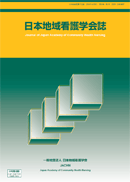Volume 26, Issue 1
Displaying 1-10 of 10 articles from this issue
- |<
- <
- 1
- >
- >|
Original Article
-
2023 Volume 26 Issue 1 Pages 4-12
Published: 2023
Released on J-STAGE: April 26, 2023
Download PDF (885K)
Research Reports
-
2023 Volume 26 Issue 1 Pages 13-21
Published: 2023
Released on J-STAGE: April 26, 2023
Download PDF (826K) -
2023 Volume 26 Issue 1 Pages 22-31
Published: 2023
Released on J-STAGE: April 26, 2023
Download PDF (804K) -
2023 Volume 26 Issue 1 Pages 32-40
Published: 2023
Released on J-STAGE: April 26, 2023
Download PDF (807K) -
2023 Volume 26 Issue 1 Pages 41-49
Published: 2023
Released on J-STAGE: April 26, 2023
Download PDF (860K) -
2023 Volume 26 Issue 1 Pages 50-58
Published: 2023
Released on J-STAGE: April 26, 2023
Download PDF (767K) -
2023 Volume 26 Issue 1 Pages 59-68
Published: 2023
Released on J-STAGE: April 26, 2023
Download PDF (781K) -
2023 Volume 26 Issue 1 Pages 69-76
Published: 2023
Released on J-STAGE: April 26, 2023
Download PDF (786K)
Informations
-
2023 Volume 26 Issue 1 Pages 77-83
Published: 2023
Released on J-STAGE: April 26, 2023
Download PDF (792K) -
2023 Volume 26 Issue 1 Pages 84-91
Published: 2023
Released on J-STAGE: April 26, 2023
Download PDF (772K)
- |<
- <
- 1
- >
- >|
